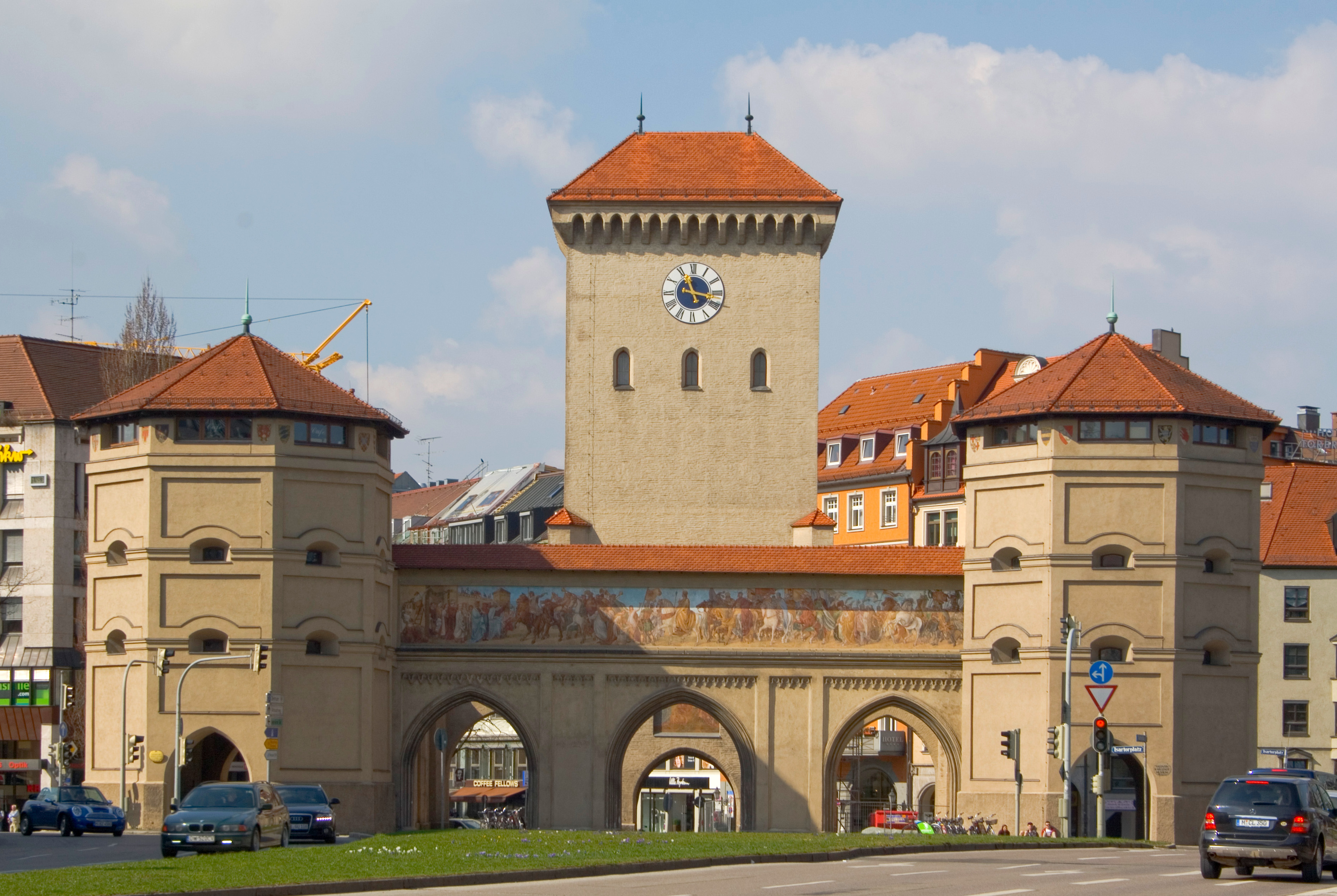Isartor on:
[Wikipedia]
[Google]
[Amazon]

 The Isartor at the Isartorplatz in
The Isartor at the Isartorplatz in
 The Isartor at the Isartorplatz in
The Isartor at the Isartorplatz in Munich
Munich ( ; german: München ; bar, Minga ) is the capital and most populous city of the States of Germany, German state of Bavaria. With a population of 1,558,395 inhabitants as of 31 July 2020, it is the List of cities in Germany by popu ...
is one of four main gates
Gates is the plural of gate, a point of entry to a space which is enclosed by walls. It may also refer to:
People
* Gates (surname), various people with the last name
* Gates Brown (1939-2013), American Major League Baseball player
* Gates McFadde ...
of the medieval city wall. It served as a fortification for the defence and is the most easterly of Munich's three remaining gothic
Gothic or Gothics may refer to:
People and languages
*Goths or Gothic people, the ethnonym of a group of East Germanic tribes
**Gothic language, an extinct East Germanic language spoken by the Goths
**Crimean Gothic, the Gothic language spoken b ...
town gates (''Isartor'', ''Sendlinger Tor
The Sendlinger Tor (translated: ''Sendling Gate'') is a city gate at the southern extremity of the historic old town area of Munich. It served as a fortification for defence and is one of Munich's three remaining gothic town gates (the other tw ...
'' and ''Karlstor
Karlstor in Munich (called Neuhauser Tor until 1791) is one of what used to be Munich's famed city wall from the medieval ages till late into the 18th century. It served as a major defensive fortification and checkpoint.
It is located at the w ...
''). The gate (German: ''Tor'') is located close to the Isar
The Isar is a river in Tyrol, Austria, and Bavaria, Germany, which is not navigable for watercraft above raft size. Its source is in the Karwendel range of the Alps in Tyrol; it enters Germany near Mittenwald and flows through Bad Tölz, Munic ...
and was named after the river.Architecture
The Isartor was constructed in 1337 within the scope of the enlargement of Munich and the construction of the ''second city wall'' between 1285 and 1337 which was completed under the Emperor Louis IV. The gate first consisted of a main gate tower. Only with the construction of the moat wall of the gate tower the two flanking side towers were added and served asbarbican
A barbican (from fro, barbacane) is a fortified outpost or fortified gateway, such as at an outer fortifications, defense perimeter of a city or castle, or any tower situated over a gate or bridge which was used for defensive purposes.
Europe ...
. The Isartor is today the only medieval gate in Munich which has conserved its medium main tower and the restoration in 1833-35 by Friedrich von Gärtner
Friedrich von Gärtner (10 December 1791 in Koblenz – 21 April 1847 in Munich) was a German architect.
Biography
His father was also an architect, and moved in 1804 to Munich, where young Gärtner received his first education in architect ...
has recreated the dimensions and appearance close to the original structure. The frescos, created in 1835 by Bernhard von Neher
Karl Josef Bernhard von Neher (16 January 1806, in Biberach an der Riß – 17 January 1886, in Stuttgart) was a German painter.
Life and work
Neher began to study painting in 1822 in Stuttgart, under Johann Heinrich von Dannecker und Philipp ...
, depict the victorious return of Emperor Louis after the Battle of Mühldorf in 1322.
The Isartor today houses a humorous museum which is dedicated to the comedian and actor Karl Valentin
Karl Valentin (born Valentin Ludwig Fey, 4 June 1882 in Munich – 9 February 1948 in Planegg) was a Bavarian comedian. He had significant influence on German Weimar culture. Valentin starred in many silent films in the 1920s, and was sometimes c ...
. A café for visitors has been integrated.
The Isartortheater, which produced Singspiele and spoken plays in the early 19th century, was destroyed in the Second World War
World War II or the Second World War, often abbreviated as WWII or WW2, was a world war that lasted from 1939 to 1945. It involved the vast majority of the world's countries—including all of the great powers—forming two opposin ...
.Seidel, Klaus J (1992), 'Munich' in ''The New Grove Dictionary of Opera
''The New Grove Dictionary of Opera'' is an encyclopedia of opera, considered to be one of the best general reference sources on the subject. It is the largest work on opera in English, and in its printed form, amounts to 5,448 pages in four volu ...
'', ed. Stanley Sadie (London) After being heavily damaged by shelling, the medieval gate was rebuilt.
The Isartorplatz is served by the S Bahn station which is named '' Isartor'' after the gate as well as 2 tram lines.
References
* {{coord, 48, 8, 06, N, 11, 34, 54, E, type:landmark_region:DE, display=title Buildings and structures completed in 1337 Buildings and structures in Munich Gothic architecture in Munich Tourist attractions in Munich Gates Munich